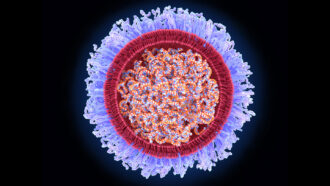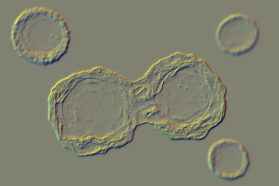Health & Medicine
-
 Health & Medicine
Health & MedicineRNA work that led to COVID-19 vaccines wins 2023 Nobel in medicine
Katalin Karikó and Drew Weissman overcame hurdles to using mRNA for medicine. This led to COVID vaccines — and maybe, one day, some for other infections.
-
 Psychology
PsychologySpending time in green spaces can provide big health benefits
Walking through a park or playing in a yard can make you feel better, both mentally and physically. Here’s how — and evidence it works for people at any age.
-
 Tech
TechA puff of air could deliver vaccines needle-free
A new Nerf gun-like device may make injections safer, faster and easier.
-
 Physics
PhysicsScientists Say: X-ray
X-rays are a type of light that doctors use to image the inside of the body. Astronomers use X-rays to explore the cosmos.
-
 Tech
TechNanobots can now enter brain cells to spy on what they’re doing
Fleets of advanced versions may one day be able to detect disease and then go about surgically treating it — without ever opening the skull.
By Nikk Ogasa -
 Tech
TechThis electronic bandage sterilizes wounds with flashes of light
Dentists have sterilized medical equipment with ultraviolet-C light for years. Applying this tech to bandages had proven a challenge — until now.
-
 Health & Medicine
Health & MedicineHigh blood pressure can affect kids but often goes undiagnosed
Left untreated, it can lead to lasting problems, even in kids who appear otherwise healthy. Learn the signs and what to do.
By Erin Ross -
 Health & Medicine
Health & MedicineExplainer: High blood pressure stresses the heart and blood vessels
Because it can be dangerous, doctors should regularly screen for it even in young kids and teens — but often don’t.
By Erin Ross -
 Health & Medicine
Health & MedicineStem cells can help build lab-grown organs that mimic real life
Making such organoids with 3-D printing and other tech can help researchers learn more about many troubling and potentially deadly disorders.
-
 Tech
TechA ‘mini cyclone’ helps detect coronavirus in the air
A new device can detect from seven to 35 coronavirus particles per liter of air in minutes. That’s close to a PCR test’s sensitivity — but much quicker.
-
 Health & Medicine
Health & MedicineSwollen chambers in astronauts’ brains may take 3 years to recover
How long astronauts spend in space and the time since their last mission affects how much fluid-filled chambers in their brains expand while in space.
-
 Computing
ComputingTeen-created software IDs skin conditions, risky drivers and more
Researchers at the 2023 Regeneron ISEF unveiled computer programs to diagnose skin conditions, warn of dangerous driving and translate sign language.